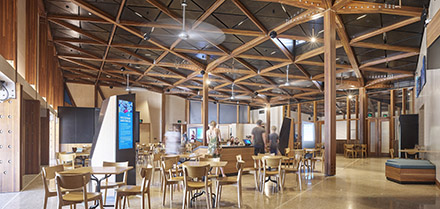
Daramu House, Barangaroo, by Tzannes. Development & Construction by Lend Lease. Photography by The Guthrie Project.
The research, conservation and visitor centre dedicated to nesting sea turtles on Mon Repos Beach in Queensland and Daramu House in Barangaroo, Sydney, have been shortlisted for the World Architecture Festival 2021 Best Use of Certified Timber award. Source: Timberbiz
This year’s eight shortlisted projects highlight the work of practices across the world, from Denmark to Tokyo, that push new boundaries in the use of certified timber, in terms of construction, sustainability and aesthetics.
Queensland’s Mon Repos Beach research centre is an impressive glulam timber structure by KIRK architects. Daramu House in Barangaroo, Sydney, by Tzannes, has a distinctive sculptural form which features an impressive 18m span in timber, pushing the limits of timber construction and making it a world leader in sustainability.
This year the eight shortlisted teams will present their projects to the jury, consisting of Keith Bradley of Feilden Clegg Bradley Studios, Carin Smuts of CS Studio Architects, Darryl Condon of HCMA Architecture + Design, and a PEFC representative, before the winning project is announced live on the final day of the festival.
The prize rewards architects and project teams for using certified timber as the main construction material for buildings outstanding in sustainability, innovation, quality or aesthetics.
This year’s shortlisted projects also include The Ariake Gymnastics Centre, a purpose-built venue for the Tokyo Olympic and Paralympic Games, by Nikken Sekkei + Shimizu Corporation. The 12,000-capacity building is defined by a striking timber floating vessel that wraps around it, and extensive timber throughout: a commitment to sustainability and an homage to the district’s historical connection to the timber industry.
The shortlist also features the largest cross laminated timber (CLT) building in the United States, and first large-scale mass timber residence hall, Adohi Hall, University of Arkansas by Leers Weinzapfel Associates lead Architects for consortium with Modus Studio and Mackey Mitchell Architects.
Also nominated is New Zealand’s the Scion Innovation Hub, Te Whare Nui o Tuteata, a workplace located on the edge of the redwood forest in Whakarewarewa Forest Park. Its curated exhibition of wood-fibre technology is curated beneath a trio of glulam timber ‘peaks’, making it a cutting-edge showcase for engineered timber, while the Harbour Kiosk in Hong Kong by LAAB Architects features 49 robotic arms behind the profiled timber fins, creating an engaging kinetic piece of public architecture.
“It is inspiring to see the large variety of buildings in the finals, benefitting from the use of certified timber in so many ways. While some of the architects chose timber for its flexibility and robustness, others appreciate its natural look and the positive effects it has for people, climate and the planet,” Ben Gunneberg, CEO of PEFC International, said.
“Our expertise lies in managing forests sustainably, PEFC is pleased to partner with WAF to promote responsible timber sourcing helping architects and their clients to request full traceability as well as reduce the carbon footprint of the buildings.”
In 2019, the prize was awarded to Western Australia’s Pingelly Recreation and Cultural Centre by iredale pedersen hook architects and Advanced Timber Concepts while a high commendation was awarded to Turo de la Peira’s Sports Centre by Anna Noguera and Javier Fernandez.
The festival will take place 1-3 December in Lisbon, Portugal. It was moved from the original dates in June due to the ongoing uncertainty created by COVID-19.






